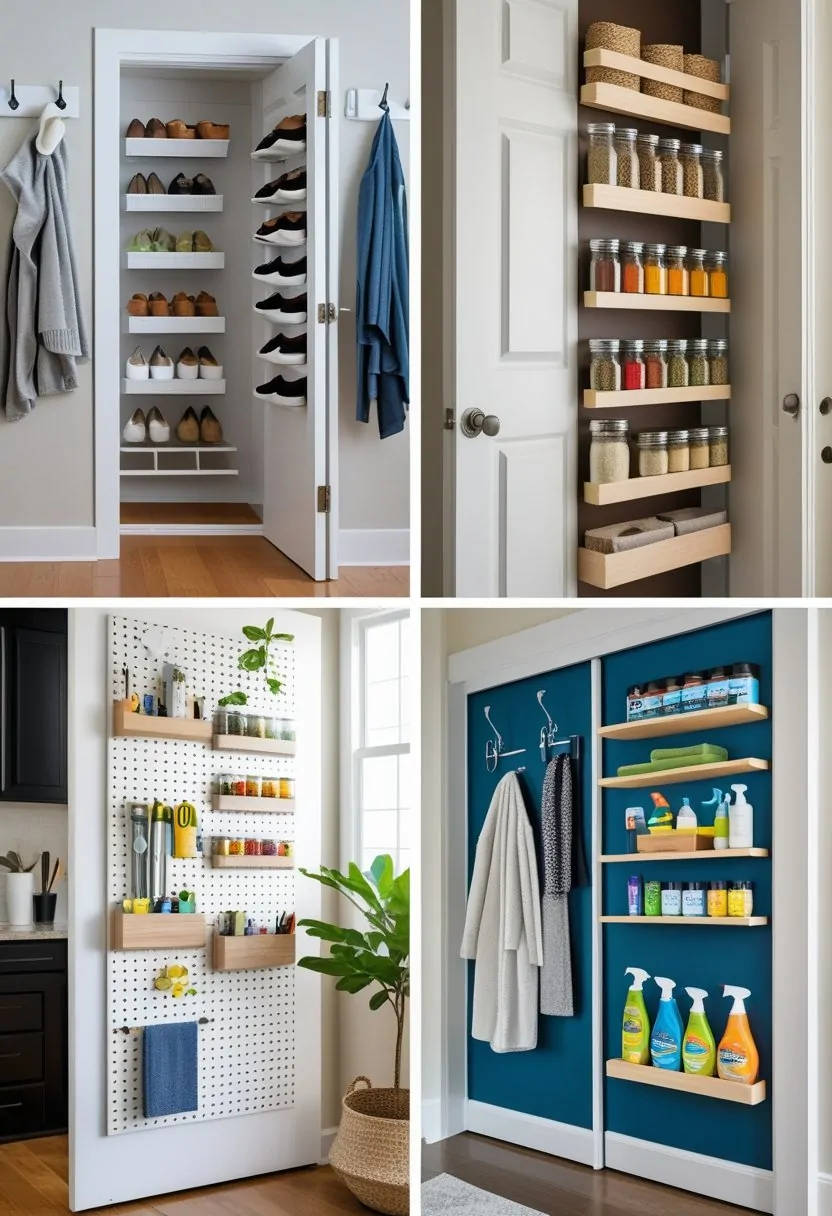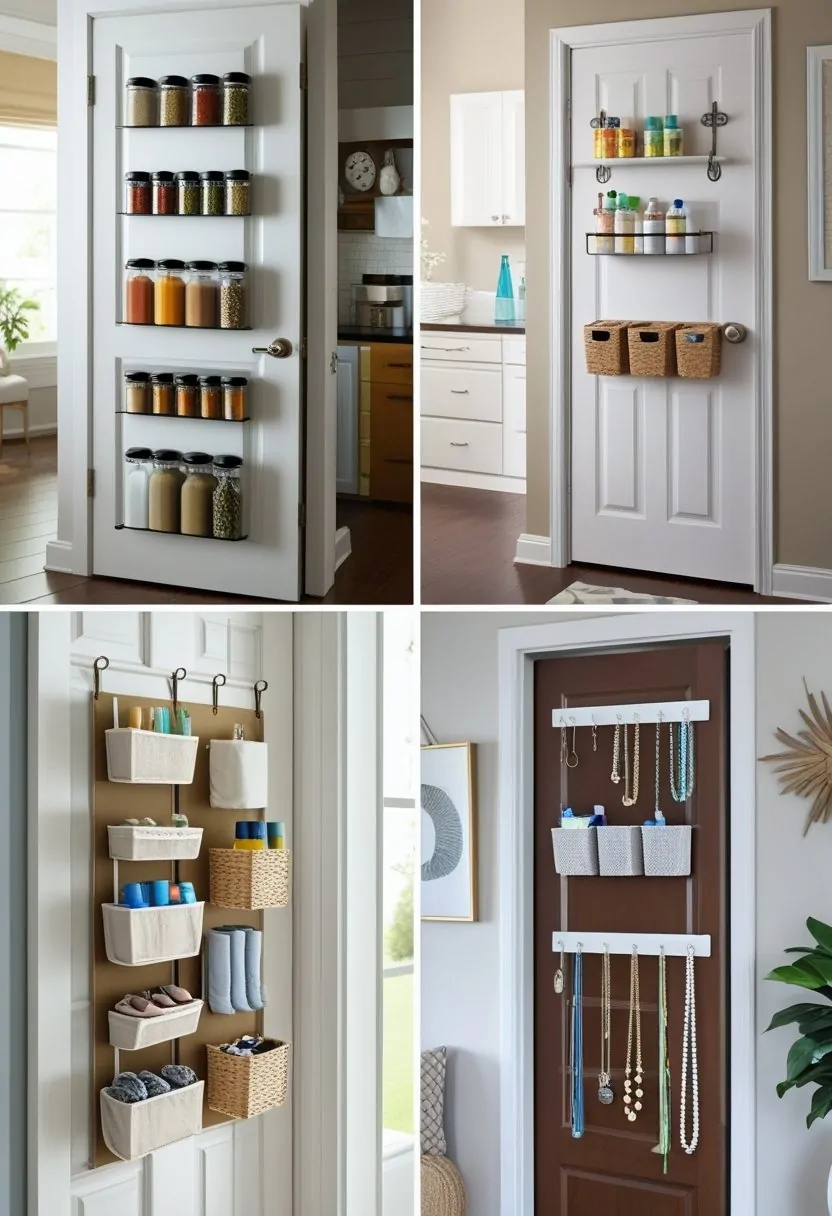4 Creative Behind-Door Storage Ideas for Stylish Homes
Maximizing hidden space behind doors offers practical and stylish solutions for home organization. This Pinterest-style collage highlights four distinct examples that blend creativity with functionality, demonstrating how often-overlooked areas can be transformed into useful storage zones.

From wooden shelves for potted plants to deep teal entryways with hooks and baskets, these ideas show how to use behind-the-door space efficiently without sacrificing style. The assortment also features a minimal wooden wall organizer paired with a hanging plant, as well as colorful bins for toys in a children’s room, each designed to keep clutter at bay while enhancing the room’s aesthetic.
These examples prove that smart, well-designed storage behind doors can improve everyday living by utilizing space that typically goes unused.
Pinterest-Style Behind-the-Door Storage Collage Overview

This collage highlights how utilizing space behind doors can blend style and practicality through thoughtful design choices. It shows a range of storage ideas that balance aesthetics with function in various home areas. Each example reflects a method to make hidden spaces useful without cluttering visible rooms.
Visual Inspiration and Key Themes
The collage demonstrates creative storage solutions using natural materials, bold colors, and playful patterns. Wooden shelves and wall organizers emphasize warmth and simplicity, ideal for plants or lightweight items. The use of deep teal paired with practical items like hooks, baskets, and hats creates a welcoming yet organized entryway.
Colorful fabric bins inject vibrancy into a child’s space while keeping toys contained. Hanging plants add a decorative touch without sacrificing storage. The examples focus on vertical space and compact designs that fit seamlessly behind doors, promoting efficient use of often overlooked areas.

Benefits of Hidden Storage in Home Organization
Hidden storage behind doors maximizes unused space, reducing clutter in main living areas. It offers discreet places for diverse items such as shoes, plants, coats, or toys, keeping rooms tidy and functional. This approach supports small-space living by increasing storage without requiring extra floor area.
Such solutions also improve accessibility, as items stored behind doors remain easy to reach but out of sight. This enhances room aesthetics and creates a calmer environment. Integrating style through colors, textures, and organized compartments adds personality while maintaining order.
Creative Examples of Behind-the-Door Storage Solutions

These examples demonstrate how behind-the-door storage can blend functionality with aesthetics. They use a variety of materials, colors, and organizational tools to make the most of limited space without cluttering the room.
Wooden Shelves with Potted Plants
Wooden shelves mounted behind a door provide a natural and decorative storage option. They hold multiple small potted plants, adding greenery to the space while utilizing an often-overlooked area.
The shelves are shallow to avoid obstructing door movement but spacious enough to accommodate several pots. This setup enhances air quality and visual interest in a subtle, space-saving way.
Maintenance involves occasional dusting and watering, making it a low-effort yet stylish method for indoor gardening. The warm tone of the wood contrasts nicely with the green plants, creating a cozy and inviting feel.
Deep Teal Entryway with Coat Hooks and Shoe Basket
A deep teal door frames a compact entryway outfitted with coat hooks, hat holders, and a basket for shoes. This color choice adds a bold and modern touch while promoting an organized environment.
The coat hooks keep outerwear accessible and off the floor, reducing clutter. The shoe basket below is designed to hold multiple pairs, preventing mess and dirt in the entry area.
This combination is perfect for small foyers or apartments where space is limited. It balances practicality with style through functional storage paired with a rich, calming color.
Minimal Wall Organizer and Hanging Plant
A minimal wooden wall organizer behind a door serves as a catchall for keys, mail, and small daily essentials. It keeps frequently used items in one dedicated spot near the entrance, fostering routine and efficiency.
Paired with a hanging plant, the setup brings freshness and life to a bright, airy entry space. The minimalist design avoids visual clutter and works well in modern or Scandinavian-inspired interiors.
This solution suits those seeking a clean, functional area without sacrificing the decorative element. It combines simple materials and greenery for a balanced look.
Colorful Polka-Dot Fabric Bins in Children’s Room
Polka-dot fabric bins arranged on shelves behind a door provide an attractive and practical storage system for toys. The colorful patterns appeal to children while keeping their space tidy and accessible.
Each bin can be dedicated to a specific category, such as blocks, dolls, or craft supplies, making cleanup faster and teaching organizational habits. The soft fabric reduces noise when accessing toys and is lightweight to move.
This storage style is adaptable as the child grows, allowing for bin swaps or repurposing. It brings order and cheerfulness to a child’s room by maximizing an otherwise unused area.
Types of Behind-the-Door Storage Options

Behind-the-door storage can take many forms depending on the needs of the space. The solutions often balance functionality with style, offering ways to hold everything from plants to shoes and toys. Materials and designs vary widely, fitting diverse decor and organizational goals.
Shelving Units and Ledges
Shelving units are ideal for holding items that need to remain visible and accessible. They can be made from wood, metal, or a combination, designed to fit shallow or deep spaces behind a door. Wooden shelves are often chosen for their warmth and ability to complement natural or rustic interiors.
Ledges offer a minimalist approach, perfect for small plants, picture frames, or lightweight decorative items. A sturdy shelf unit can hold heavier items such as baskets or storage bins, making it practical for entryways or kitchens. These units use vertical space efficiently without obstructing door movement.
Hanging Organizers and Hooks
Hanging organizers are versatile, frequently used for smaller items like hats, scarves, or keys. Fabric or mesh pockets allow easy sorting and visibility. Hooks provide quick storage for coats, bags, or kitchen tools, depending on the room.
They are easy to install and often adjustable, allowing users to customize the arrangement to their needs. Hooks combined with small racks can optimize space further, especially in narrow entryways or closets. Hanging organizers help keep items off the floor while maintaining accessibility.

Fabric Bins and Baskets
Fabric bins and baskets are common for storing soft or loose items. They come in various sizes and patterns, suitable for children’s toys, linens, or personal accessories. Polka-dot or colorful bins add a decorative element without sacrificing organization.
These containers slide easily on and off shelves, making cleanup and item retrieval straightforward. Fabric materials keep the storage lightweight and flexible, useful behind doors in bedrooms or playrooms. Bins also protect items from dust while keeping them contained.
Maximizing Functionality and Style

Effective behind-the-door storage combines durable, suitable materials with a thoughtful visual approach. This balance ensures the space meets daily needs while enhancing the room’s overall look.
Choosing Materials and Finishes
Materials must match the space’s function. Wood offers strength and warmth, ideal for shelves holding plants or heavier objects. Metal hooks and baskets suit entryways where durability is necessary to support coats and shoes.
Finishes should resist wear and complement surrounding surfaces. For example, smooth paint or laminate finishes prevent scratches in high-traffic areas. Natural or matte finishes on wood add texture without overwhelming a small space.
Selecting moisture-resistant materials is critical in entryways or rooms prone to humidity. Easy cleaning surfaces maintain freshness and appearance over time.
Blending Storage with Room Decor
Storage solutions should visually integrate with room style. Coordinating colors—such as the deep teal entryway—create cohesion. Patterns, like polka-dot fabric bins, add playful accents but remain functional.
Using natural elements like plants softens the look and brings warmth to minimal setups. Consistent design features, such as wooden organizers matching door tones, establish harmony without clutter.
Effective integration respects both aesthetics and accessibility, striking a balance between visible decor and practical storage behind doors.
Practical Tips for Installation and Maintenance

Proper measurement, secure mounting, and consideration of safety enhance the functionality of storage solutions behind doors. Ensuring easy access while maximizing space requires careful planning and regular upkeep.
Measuring and Fitting Storage Behind Doors
Accurate measurements of door width, clearance, and swing are essential. The depth of shelves or organizers should allow the door to close fully without obstruction. Measure the thickness of the door and adjacent walls to avoid overcrowding.
Using a level during installation ensures shelves and hooks are straight and stable. Select hardware that supports the weight of stored items, considering drywall anchors or studs for heavy loads.
Plan the layout to accommodate frequently used items within easy reach, leaving space for door handles and hinges. For rental properties, removable or non-permanent options like adhesive hooks maintain the wall’s condition.
Safety and Accessibility Considerations
Storage should not block emergency exits or hinder door operation. Clear access is critical, especially in entryways and children’s rooms where unobstructed movement is necessary.
Items stored behind doors must be secure to avoid falling when the door is opened or closed quickly. Soft-close hinges or door stoppers reduce impact and potential damage.
Accessibility also means considering user height and mobility. Install hooks and shelves at levels reachable by all household members, and avoid sharp edges or protrusions that could cause injury.
Regular inspection of mounts and contents prevents wear that could lead to accidents or structural failure.
Room-by-Room Ideas for Hidden Storage

Maximizing hidden storage depends on tailoring solutions to the specific needs of each room. Using furniture with built-in compartments, hooks, bins, and shelves behind doors can keep spaces uncluttered while maintaining functionality and style.
Entryway Solutions
Entryways benefit from multipurpose furniture such as benches with lift-up lids or built-in baskets for stashing shoes and accessories. Hooks behind doors provide convenient places for coats, hats, and bags, keeping clutter off floors and main walls.
Wooden shelves behind doors can hold small plants or decorative items, adding warmth without sacrificing storage space. Using deep bins or baskets behind doors helps contain miscellaneous items, making entryways neater and more welcoming.
Children’s Room Organization
Hidden storage in children’s rooms can include colorful fabric bins placed on shelves tucked behind doors. These bins provide easy access to toys while keeping them out of sight, promoting tidiness without sacrificing play area.
Wall organizers mounted behind doors offer additional space for books, art supplies, and small toys. Combining storage with playful elements like hanging plants or colorful containers adds personality while maintaining order.
Bathrooms and Laundry Spaces
Behind-the-door storage in bathrooms or laundry rooms should focus on practicality. Slim shelves or racks can hold toiletries, cleaning supplies, or towels, making the most of small spaces.
Hooks and baskets behind doors keep frequently used items within reach but off counters. Waterproof bins or containers work well for storing detergents or personal care products, preventing clutter in limited square footage.







